
Website founded by
Milan Velimirović
in 2006
15:20 UTC


| |
MatPlus.Net  Forum Forum  General General  Albino & Pickaninny-Mate In 1, 2, 3, & 4 Albino & Pickaninny-Mate In 1, 2, 3, & 4 |
| |
|
|
|
|
You can only view this page!
| | Page: [Previous] [Next] 1 2 3 | | (1) Posted by James Malcom [Friday, Mar 27, 2020 02:36]; edited by James Malcom [20-03-27] | Albino & Pickaninny-Mate In 1, 2, 3, & 4
I had an idea inspired the end of a 1+0 blitz game I won: https://lichess.org/mqSC4yO3iCEm
Mate In 1, 2, & 3
 (= 6+5 ) (= 6+5 )
I have only managed to do a 3/4 Albino so far. However, with the opposite color, I have been able to do it in full.
BTM, Mate In 1, 2 3, & 4
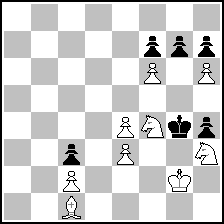 (= 9+6 ) (= 9+6 )
The only drawback to the Pickaninny is that the mating move is repeated, with a dual mate in one line. But it is nice to personally achieve it.
Can such a task be done with the Albino, or has it already been done? Unique-ish lines for each variation is needed of course.
*********
I was also inspired by this timeless problem.
Mate In 1, 2, 3, & 4
Knud Hannenmann, Dagens Nyheter, 1933
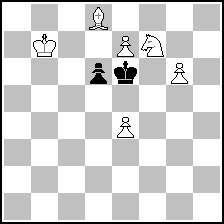 (= 6+2 ) (= 6+2 )
| | | (2) Posted by Hauke Reddmann [Friday, Mar 27, 2020 09:27]; edited by Hauke Reddmann [20-03-27] |
I bet it can be done! For starters, add a wPg7
to your first diagram. Seems already to work?!
1.gxh3 Kxh3 2.g8Q Kxh2/h4 3.Rh6 4.RxP#
There is a dual if Black plays 3...Kh3,
and of course 1.g8Q suffices :-)
So, how far do you allow duals (and cooks :-) ?
Hauke
| | | (3) Posted by Hauke Reddmann [Friday, Mar 27, 2020 10:02]; edited by Hauke Reddmann [20-03-27] |
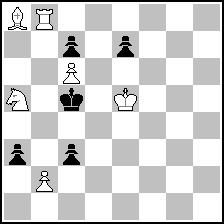 (= 6+5 ) (= 6+5 )
1.b4#
1.b3 2.b4#
1.bxa3 2.a4 3.Rb5#
1.bxc3 a2 2.Rb4 a1S 3.Ke6 4.Sb3#
Probably goes even more elegant.
And how shall we call the theme? Pickanumber? :-)))
Hauke, fastest gun in the West :-)
| | | (4) Posted by Joost de Heer [Friday, Mar 27, 2020 10:22] |
In the first diagram, 1. g4! also leads to a #3:
1.g2-g4 !
1...h5*g4
2.Kf5-g6
2...g4-g3
3.Rf6-f4 #
2.Rf6-f8
2...g4-g3
3.Rf8-h8 #
2...Kh4-h5
3.Rf8-h8 #
2.Rf6-f7
2...g4-g3
3.Rf7-h7 #
2...Kh4-h5
3.Rf7-h7 #
| | | (5) Posted by Joost de Heer [Friday, Mar 27, 2020 10:25] |
In Hauke's problem there's no exact #4, after 1. bc3 a2 2. Rb4 a1=Q there's no exact #2.
| | | (6) Posted by Jakob Leck [Friday, Mar 27, 2020 10:29] |
Hauke, your diagram allows 1.b3 2.Rb7 3.b4#.
| | | (7) Posted by James Malcom [Friday, Mar 27, 2020 16:27]; edited by James Malcom [20-03-27] |
It is an extremely elegant try Hauke, but it is unfortunately incorrect as Jakob pointed out.
Joost, while Black has options in the #4 line of Hauke's problem, as long as there as a dual free mainline and no serious deviations (akin to what Jakob pointed out), the problem is fine to me.
Here is my try at a full Albino in a rather heavy position.
Mate In 1, 2, 3, & 4
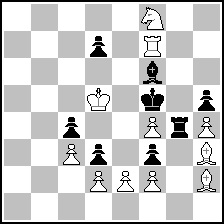 (= 11+8 ) (= 11+8 )
a) 1. e4#
b) 1. e3 d6 2. e4#
c) 1. exf3 d6 2. Bg1 Kxf4 3. Rxf6#
d) 1. exd3 d6 2. Bg1 exd3 3. c4 Kxf4 4. Rxf6#
Note that in d) if 1... bxc3 first, Bh3 and b4 are interchangeable, which is a dual but not a serious deviation.
| | | (8) Posted by Joost de Heer [Friday, Mar 27, 2020 17:26]; edited by Joost de Heer [20-03-27] |
QUOTE
Joost, while Black has options in the #4 line of Hauke's problem, as long as there as a dual free mainline and no serious deviations (akin to what Jakob pointed out), the problem is fine to me.
Dualfree is OK, but there is no exact-#4 in Hauke's position.
In your last position, there's no exact-#4 with 1. exd3, only with 1. ef3 d6 2. Bg1 Kf4 3. Bg4 hg4 4. Rf6#
| | | (9) Posted by James Malcom [Friday, Mar 27, 2020 17:44]; edited by James Malcom [20-03-27] |
It doesn't have to be "exact", so long so as a unique idea for the play is in place. For example the move order in my d) isn't set it stone, making it not exact as you have correctly said Joost. But White's general plan is the only plan that mates in time, thus making it acceptable to me given the difficulty of the task.
A promoted piece prevents a dual in this variation of my above problem.
Mate In 1, 2, 3 & 4
 (= 12+7 ) (= 12+7 )
| | | (10) Posted by Hauke Reddmann [Friday, Mar 27, 2020 22:20] |
@Joost: Yes, that was exactly what I meant.
So e.g. 1.X#, 1.Y 2.Z# but NOT playing Z you can't
even mate in 4, right?
Here's another matrix to experiment:
Ka8 Ra5 Bc8 Pf2 Pg2 - Kh4 Ph3 Pf3
You must "only" add Black material such that
a) gxh3 is not stalemate b) White can't slow
down his 2# and 3#.
| | | (11) Posted by James Malcom [Saturday, Mar 28, 2020 04:56]; edited by James Malcom [20-03-30] |
That could work Hauke, although I have nothing on it yet. Nobody wants one with a promoted piece of course, so the hunt continues!
In the meantime, here is a new and perfect Pickanumber in a Meredith for you Hauke. :^)
Mate In 1, 2, 3, & 4
 (= 6+4 ) (= 6+4 )
A correct 3/4-thanks again Jakob.
Mate In 1, 2, & 3
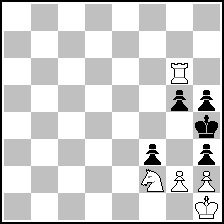 (= 5+5 ) (= 5+5 )
| | | (12) Posted by Joost de Heer [Saturday, Mar 28, 2020 10:45] |
QUOTE
It doesn't have to be "exact", so long so as a unique idea for the play is in place.
It does have to be exact. In the #4 line, a mate in an earlier move is not allowed, otherwise the #[1-3] solution would work too. So if black can defend on his second move with a move which allows a #1 but prevents a #2, then this means there's no solution for the #4-line.
| | | (13) Posted by Hauke Reddmann [Saturday, Mar 28, 2020 12:04]; edited by Hauke Reddmann [20-03-28] |
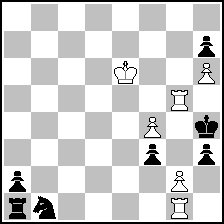 (= 6+7 ) (= 6+7 )
1.g3#
1.g4 ~ 2.Rh5# (only move)
1.gxf3 2.R1g4+ 3.Rh5# (ditto)
1.gxh3 2.R1g4+ 3.Kf5 4.Rh5#
Does this work? I see no way White can delay his mates
on any Black move.
| | | (14) Posted by James Malcom [Saturday, Mar 28, 2020 13:52] |
Not quite Hauke-1. gxf3 h2 2. R5g4+, R1g3, R1g2, #3->#4
| | | (15) Posted by Joost de Heer [Saturday, Mar 28, 2020 15:20] |
@Hauke: doesn't work. 1. gf3 S~ and no exact #2.
| | | (16) Posted by seetharaman kalyan [Sunday, Mar 29, 2020 08:11] |
@Joost.. 1.gf3 threatens Rg4# which black can defend only by 1...h3. now mate in three
| | | (17) Posted by Joost de Heer [Sunday, Mar 29, 2020 10:12] |
Seethamaran, as I said before: In an exact-#3, allowing a #1 after the first move is allowed, because it doesn't fulfill the stipulation. If it's '#3 with short variations allowed', then the #1 and #2 are cooks.
| | | (18) Posted by seetharaman kalyan [Sunday, Mar 29, 2020 10:29] |
I don't see any mention of exact #3. I understood it as a problem with #1 in diagram and different length mates after other three pawn moves.
| | | (19) Posted by James Malcom [Sunday, Mar 29, 2020 17:37]; edited by James Malcom [20-03-29] |
Like seetharaman said Joost, there is no requirement for an “exact mate.” So what Black plays a non-optimal move that reusults in a shorter mate? Black plays optimally here to whatever White plays, so suboptimal moves are not even considered. Your statement “If it's '#3 with short variations allowed', then the #1 and #2 are cooks” is worthless and wrong because Black’s suboptimal moves are not and never are considered in a directmate. Short variations are NOT accounted for whatsoever, so please don’t bother with “exact mates.”
As such, I have achieved a full Albino with a promoted piece as seen in an above post. The challenge is to now do it with only standard pieces, to which Hauke is making much appreciated efforts to.
| | | (20) Posted by Jakob Leck [Sunday, Mar 29, 2020 18:28] |
Rewan, I think I have to back up Joosts argument about the necessity of exact mates.
You should clarify your intentions or the stipulation. If you just say mate in 1, 2, 3, 4, then without the requirement of exact mates the #3 would be cooked by the #1 or the #2 (or the #2 stretched by some useless white move) and so forth. To prevent this problem you could either say that for the #n stipulation you disregard the moves leading to a #m, m<n, but this seems a little bit ugly. The other way would be to strive for exact mates. This would be really aesthetic, but also quite hard to compose, I imagine.
| |
Read more... | Page: [Previous] [Next] 1 2 3
MatPlus.Net  Forum Forum  General General  Albino & Pickaninny-Mate In 1, 2, 3, & 4 Albino & Pickaninny-Mate In 1, 2, 3, & 4 |
|
|
|
 ISC 2024
ISC 2024 Forum
Forum  General
General  Albino & Pickaninny-Mate In 1, 2, 3, & 4
Albino & Pickaninny-Mate In 1, 2, 3, & 4 


